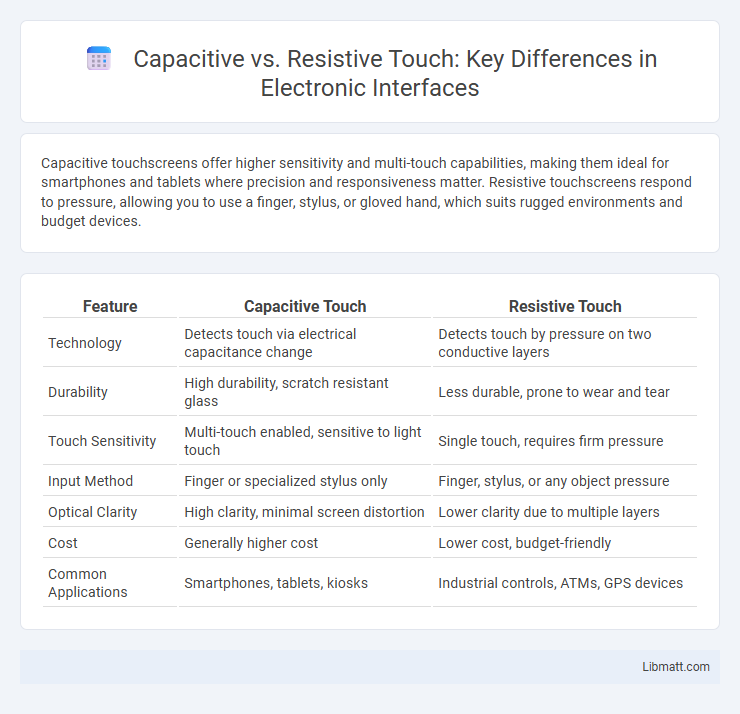Capacitive touchscreens offer higher sensitivity and multi-touch capabilities, making them ideal for smartphones and tablets where precision and responsiveness matter. Resistive touchscreens respond to pressure, allowing you to use a finger, stylus, or gloved hand, which suits rugged environments and budget devices.
Table of Comparison
| Feature | Capacitive Touch | Resistive Touch |
|---|---|---|
| Technology | Detects touch via electrical capacitance change | Detects touch by pressure on two conductive layers |
| Durability | High durability, scratch resistant glass | Less durable, prone to wear and tear |
| Touch Sensitivity | Multi-touch enabled, sensitive to light touch | Single touch, requires firm pressure |
| Input Method | Finger or specialized stylus only | Finger, stylus, or any object pressure |
| Optical Clarity | High clarity, minimal screen distortion | Lower clarity due to multiple layers |
| Cost | Generally higher cost | Lower cost, budget-friendly |
| Common Applications | Smartphones, tablets, kiosks | Industrial controls, ATMs, GPS devices |
Introduction to Touchscreen Technologies
Capacitive touchscreens detect touch through the electrical properties of the human body, offering high sensitivity and multi-touch capabilities, making them ideal for smartphones and tablets. Resistive touchscreens rely on pressure applied to two flexible layers, providing accurate input with any object, including gloves or styluses, commonly used in industrial and medical environments. Both technologies serve distinct use cases by balancing durability, sensitivity, and user interface requirements.
What is Capacitive Touch?
Capacitive touch technology uses the electrical properties of the human body to detect touch inputs on a screen. It relies on a layer of capacitive material that stores electrical charge, which changes when a finger or conductive object makes contact, allowing precise and multi-touch detection. Widely used in smartphones and tablets, capacitive touchscreens offer high sensitivity, durability, and clarity compared to resistive touch technology.
What is Resistive Touch?
Resistive touch technology operates by detecting pressure applied to the screen, using two flexible layers separated by a narrow gap that make contact when pressed. This type of touch screen is highly responsive to input from fingers, styluses, or any pointed objects, making it versatile for various devices. Resistive touchscreens are known for their durability, affordability, and ability to function accurately in different environmental conditions, including exposure to water and dust.
How Capacitive Touchscreens Work
Capacitive touchscreens operate by detecting the electrical properties of your skin, using a layer of capacitive material that stores electrical charge. When you touch the screen, the charge is altered at the contact point, enabling precise location detection. This technology offers high sensitivity and supports multi-touch functionality, making it ideal for smartphones and tablets.
How Resistive Touchscreens Work
Resistive touchscreens operate by detecting pressure applied to their surface, consisting of multiple flexible layers separated by a small gap. When a user presses the screen, the top layer deforms, causing it to make contact with the bottom layer, which registers the touch location through changes in electrical resistance. This technology allows for precise input using fingers, styluses, or other objects, making resistive screens versatile for various applications.
Sensitivity and Accuracy Comparison
Capacitive touchscreens offer higher sensitivity and accuracy by detecting changes in the electrical field caused by the conductive properties of the human finger, enabling precise multi-touch gestures and swift response times. Resistive touchscreens rely on pressure from any object, resulting in lower sensitivity and reduced accuracy, especially for fine or rapid inputs. Capacitive technology excels in environments demanding high precision and responsiveness, while resistive screens suit applications needing input flexibility but tolerate less accuracy.
Durability and Longevity
Capacitive touchscreens offer superior durability due to their glass surfaces, which resist scratches and maintain sensitivity over extended periods. Resistive touchscreens, composed of multiple flexible layers, are more prone to wear and tear, leading to decreased accuracy and responsiveness after prolonged use. Longevity of capacitive screens typically surpasses resistive ones, making them ideal for high-usage environments.
Environmental Suitability
Capacitive touchscreens offer high sensitivity and multi-touch capabilities, making them ideal for clean indoor environments with minimal dust or moisture. Resistive touchscreens perform reliably in harsh conditions, including extreme temperatures, dirt, and water exposure, due to their pressure-based input mechanism. Your choice depends on the environmental suitability needed for consistent and accurate touch performance.
Cost and Application Scenarios
Capacitive touchscreens generally have higher upfront costs due to advanced materials like indium tin oxide and complex manufacturing processes, making them ideal for smartphones, tablets, and interactive kiosks where multi-touch and high responsiveness are essential. Resistive touchscreens, being cheaper and simpler in construction with layers that detect pressure, are preferred in industrial settings, point-of-sale terminals, and outdoor devices where durability and operation with gloves or styluses are required. Choosing between capacitive and resistive touch technology depends on balancing budget constraints with specific application needs such as touch sensitivity and environmental durability.
Choosing the Right Touchscreen Technology
Choosing the right touchscreen technology depends on your device's intended use and environment, with capacitive touchscreens offering high sensitivity and multi-touch capabilities ideal for smartphones and tablets. Resistive touchscreens provide better durability and work well with gloves or styluses, making them suitable for industrial or outdoor applications. Evaluating factors like budget, precision needs, and user interaction will help you determine the best option for your touchscreen device.
Capacitive vs Resistive Touch Infographic

 libmatt.com
libmatt.com